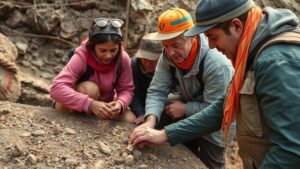Investigating the technology used to create the massive geoglyphs in Saudi Arabia.
Investigating the Technology Used to Create the Massive Geoglyphs in Saudi Arabia
In recent years, the discovery of large geoglyphs in Saudi Arabia has sparked immense interest among archaeologists and historians alike. These impressive structures, which can be seen from great heights, were created using advanced techniques and technologies that highlight the ingenuity of ancient civilizations. Understanding the methods behind these geoglyphs allows us to appreciate their historical significance and the cultural practices of the communities that built them.
Historical Context of Geoglyphs in Saudi Arabia
The geoglyphs, commonly referred to as gates or kites, date back to the Late Neolithic period, around 4000-2000 BCE. are predominantly located in the northwestern region of Saudi Arabia, particularly in the Harrat Khaybar area. Archaeological studies suggest that these structures may have functioned as traps for hunting animals, facilitating sustainable resource management in an otherwise arid landscape.
Geographical Distribution and Characteristics
The geoglyphs are scattered across the Saudi desert, with over 1,600 identified structures, covering various forms ranging from linear formations to more complex shapes like circles and quadrilaterals. Notable examples include:
- The Kites: These consist of long, straight walls leading to a circular enclosure and are designed to funnel animals into the designated area.
- The Gates: Often resembling a pair of doors, these structures date back to ancient hunting methods and underscore the regions reliance on animal resources.
Technological Advancements Behind the Construction
The construction of the geoglyphs likely involved a combination of impressive teamwork, skilled labor, and rudimentary technology. Here are key elements that researchers believe contributed to their creation:
- Surveying Techniques: It is speculated that ancient builders used tools resembling modern surveying equipment to calculate and mark the sites where geoglyphs were to be constructed.
- Community Collaboration: Building these massive structures would have required significant manpower, suggesting that social organization and collective effort were crucial to their realization.
- Terrain Adaptation: Builders demonstrated a deep understanding of local geography, utilizing natural landforms to enhance the design and functionality of geoglyphs.
Scientific Techniques Used in Modern Investigations
In recent times, various scientific methods have been employed to study these ancient geoglyphs, offering deeper insights into their construction and purpose:
- Satellite Imaging: Remote sensing technologies have allowed researchers to uncover hidden structures beneath the desert sands, enhancing our understanding of geoglyph distribution.
- Aerial Surveys: Drones equipped with high-resolution cameras assist in generating detailed maps of the geoglyphs, providing information on their dimensions and geometry.
Implications for Understanding Ancient Societies
The study of these massive geoglyphs not only reveals the technological prowess of ancient cultures but also illuminates their social structures, economic practices, and environmental adaptations. The existence of these structures indicates:
- Advanced agricultural and hunting strategies, reflective of well-planned community organization.
- Strong connections between humans and the unique landscape of Saudi Arabia, suggesting a sustainable coexistence with nature.
Case Studies and Real-World Applications
Geoglyphs are not isolated phenomena; their study offers parallels to similar structures worldwide, such as the Nazca Lines in Peru. The analysis of such sites can inform contemporary archaeological methodologies, enhancing our approach to exploring how ancient societies manifested their cultural identities through environmental manipulation.
Conclusion
The massive geoglyphs of Saudi Arabia stand as a testament to the ingenuity of ancient peoples and their advanced understanding of technology and ecology. As investigative technologies evolve, our comprehension of these fascinating structures continues to grow, offering valuable lessons about sustainability and community organization from our ancestors.
For scholars, archaeologists, and enthusiasts alike, exploring the depths of these geoglyphs provides not only insight into the past but also valuable strategies that can inform modern-day practices in resource management and environmental conservation.



